Projects of articulated tanks Boirault Train Blindé (France)
In previous projects, L. Buaro tried to increase the maneuverability of the machinery through the use of a caterpillar consisting of several large sections-frames. Now it was planned to improve the mobility parameters by changing the overall architecture of the armored vehicles. The Boirault Train Blindé (Armored Train of Bouarot) was to consist of several sections with its own chassis, connected by special hinges. Not without irony, it is worth noting that the appearance of such a project was expected: prior to the commencement of work in the field of military technology, Monsieur Bouarot was engaged in the creation of various components and assemblies for railway transport.

Layout of the "Armored Train Bouaro" first model
Forming the overall appearance of the “tank-armored train”, the French designer rightly reasoned that an increase in the characteristics of maneuverability could not be achieved only by increasing the bearing surface of the tracks. By that time, it was already known that the increase in the size of the tracked propulsion unit could even worsen the characteristics of the technology. To solve the existing problem, it was necessary to use several sets of tracks located on separate shells. Between themselves, the latter should be connected with special design hinges.
The main feature of the proposed architecture of armored vehicles was the possibility of mutual movement of the corps within a certain sector. Due to this, it was assumed that the tank could overcome various ascents and descents, as well as cross trenches, craters and other obstacles without significant problems. In general, a serious increase in the cross-country ability over the rough terrain characteristic of the battlefields of the First World War was expected.
The first project of the Boirault Train Blindé family was planned to be simplified through the use of a number of ready-made components, the source of which was to serve the existing mass-produced armored vehicles. Moreover, as part of the "tank-armored train" should use two serial tanks of the same model. After a number of minor improvements and the installation of some new components, these machines had to be connected to an additional section-hull, resulting in a full-fledged tank of articulated design.
The proposed tank consisted of three sections of different designs, connected by special hinges. The front and rear sections of the armored vehicle were supposed to be a converted Saint Chamond medium tanks. The central section was designed by L. Bouarot from scratch, but with extensive use of parts from existing armored vehicles. In particular, it had to be equipped with the undercarriage of an already used tank, modified in accordance with the existing requirements.
The front section of the Boirault Train Blindé tank of the first model was to retain the recognizable appearance of the Saint-Chamon tank. Provided for the use of multiple frontal sheets mounted at different angles to the horizontal and vertical. The central part of the body had a box-shaped structure of rectangular section. Korm was asked to finalize due to the need to use the hinge. The back of the case has lost its overhang, instead of which there was now a vertical wall with knots for fastening the hinge parts. A running gear was used with a large number of interlocked support rollers with helical springs.
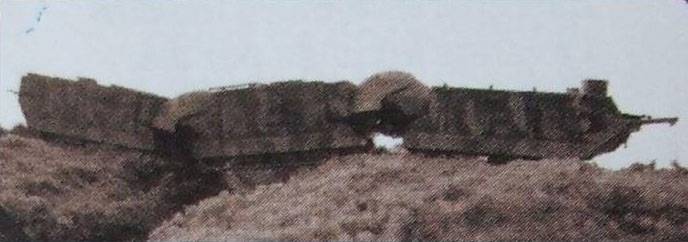
Layout of the tank on "rough terrain"
The central section of the tank was a unit with a box-shaped hull, the front and rear walls of which received devices for connecting with other hulls. Caterpillars passed along the entire length of the bottom. From the other sections of the central differed reduced length. This feature of its design was associated with the placement of the minimum necessary amount of equipment.
The aft section, like the front one, was based on the design of the existing tank, but it had significant differences. This time the hull of the base tank was deprived of a front overhang with a gun mount. Instead, it was proposed to use a vertical front sheet with hinge elements. At the same time, the section kept the stern with a vertical upper and inclined lower sheets.
In the original version, the medium tank Saint-Chamon was equipped with frontal armoring 17 mm thick, sides of steel 8,5 mm thick and 8 mm stern. The roof and the bottom were made of 5 mm thick sheets. There is no detailed information about the protection of the articulated tank of L. Buaro, but there is every reason to believe that the design of the armored corps should have undergone minimal changes and, as a result, should maintain the existing level of protection.

Overcoming the trench
The most important feature of the Saint Chamond tank was the use of an electric transmission. Apparently, it is this feature of the project that led to the choice of such equipment as the main elements of the “tank-armored train”. The project Boirault Train Blindé implied the dismantling of Panhard gasoline engines with 90 horsepower available on the base tanks. Together with them, their own electric generators were also removed. At the same time, in the sections, two traction electric motors were kept connected with the drive wheels of the tracks. In each of the three sections of the armored vehicle should be placed on a pair of own engines.
As a means of powering six electric motors of three sections, it was proposed to use a common generator set, located in the central building. The existing case of a relatively large volume allowed to place in the central section a gasoline engine with an 350 horsepower. and a generator with the required parameters. The generator and traction motors were connected using cables passing through the hinges of the housings. The use of electrical equipment made it possible to significantly simplify the design of the transmission, eliminating the need to hold the shafts through the hinge, as well as to give the armored vehicle the required power. In addition, a high degree of unification of the traction motors and their control systems was achieved.
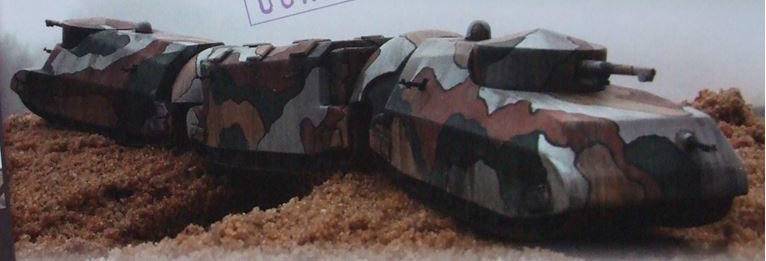
Model of the articulated tank Boirault Train Blindé second version
The sections of the prospective tank were to be connected to each other with the help of two hinges, based on the ideas of the driveline. It was proposed to fasten supports with clamps-forks, capable of rotating around their longitudinal axes, on the body sections. The connection of two supports was provided with a cross with a set of fasteners. This design of the hinge allowed the sections to move relative to each other within certain horizontal and vertical sectors. Details of the hinge were proposed to be placed in the lower part of the body, approximately at the same level with the running gear.
The used hinge ensured free movement of sections within permissible angles, but in some situations this was a disadvantage. For this reason, shock absorbers with limiter functions have been introduced into the design of the articulation mechanism. On the sides of the universal joint at an angle to the horizontal should be placed spring or other shock absorbers with a movable rod. The latter was attached to the wall of the front or rear section, and the elastic elements were to be in the center.
In later versions of the project, the joint was supplemented with section motion control systems. For this it was proposed to use a set of low-power electric motors with drums located in the central section and responsible for winding control cables. By changing the length of the cables connected to other sections, it was possible to adjust the position of the machine’s aggregates. Such a mechanism, in particular, facilitated maneuvering.
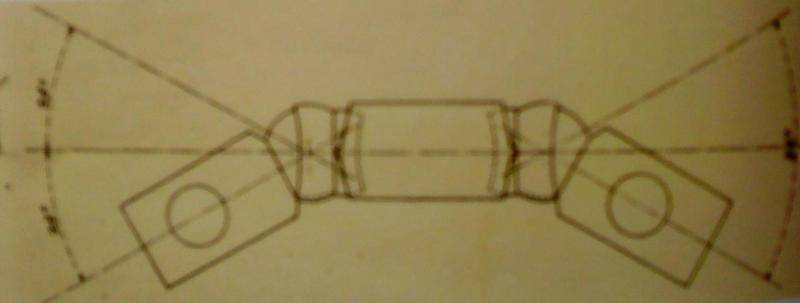
Scheme of possible movements of the section in the horizontal plane
The proposed hinge and some other mechanisms could cope with the tasks assigned to them, but were placed openly, which in a combat situation could lead to the breakdown of certain parts with loss of maneuverability or mobility. To protect the hinge and control devices, it was proposed to use the original form of armor covers. L. Buaro developed a system of two curved armor parts, the shape of which was close to hemispherical. One of the parts was mounted on the rear wall of the first section, the second - on the front wall of the central case. One hemispherical casing went inside the other, and together they provided protection for the hinge. Due to its hemispherical shape and a set of notches, armor covers allowed tank sections to move freely within the allowable sectors.
The widespread use of existing tank units led to the formation of a corresponding set of weapons. In the frontal part of the front hull it was planned to install an 75-mm gun with the possibility of horizontal guidance within a sector of width 16 ° and with vertical aiming from -4 ° to + 10 °. Also in the front and aft sections should be placed several installations for machine guns caliber 8 mm.
Calculations showed that the length of the promising tank would reach 18-20 m. Other dimensions could remain at the same level. The preservation of some units of the hull made it possible to get the width of the 2,67 machine m and the height of no more than 2,4 m. The calculated combat weight of the Boirault Train Blindé tank reached 75 t. According to known data, the design of the hinge connecting sections of the armored car, allowed them to move at an angle of up to 30 °. Thanks to this, the tank in theory could overcome various obstacles, showing superiority over other armored vehicles of the time.
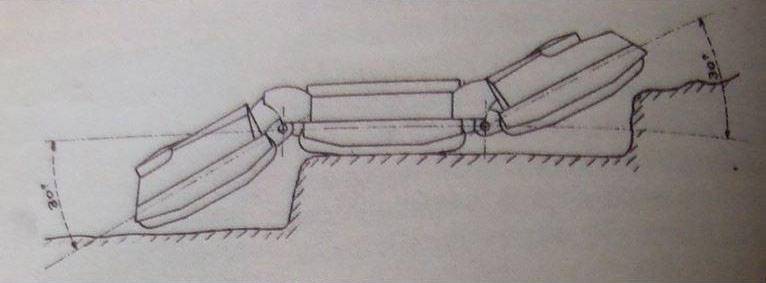
Overcoming obstacles by moving sections in a vertical plane
The first version of the "tank-armored train" could be of some interest in terms of technology and possible combat use. However, due to the wide use of off-the-shelf components, the armored car should have some noticeable flaws. Thus, the preservation of the existing Saint Chamond tank gun installation imposed serious restrictions on the firing. With the help of pointing drives, the gun moved within a not too wide sector, and turning the entire machine was required to carry fire to large angles. In addition, the use of a modified serial type tank could lead to the manifestation of new problems.
To correct the existing shortcomings, L. Bouarot created a new project based on the same ideas. The second version of the armored vehicle Boirault Train Blindé also had to consist of three sections with different equipment, but differed from the first design of the extreme sections, the composition of the power plant, weapons, etc. It is noteworthy that when creating an improved project, the French designer retained the existing hinges and their protection. In addition, it was in this project that section positioning controls were proposed.
In the second project of the “tank-armored train” it was proposed to use the first and third sections of a similar design. Due to this, it was possible to simplify the mass production of equipment while achieving the highest possible performance. Between the two sections with the crew and weapons should be placed central, accommodating the main units of the power plant. Two sections of the new version of the tank were to be equipped with armored hulls of improved design. The enclosures used parts with a thickness from 16 to 32 mm, which made it possible to significantly increase the protection performance in comparison with the previous project.
Protection of the frontal projection of the improved case of the front section was provided by a curved inclined bottom sheet and a large slab placed at an angle to the horizontal. On the sides of them were placed side, consisting of two parts. The bottom sheet was proposed to be placed vertically, the top - with a slope inward. In the aft part of the hull there was a unit of increased height, in front of which there was a tower shoulder strap. The latter was located in the center of the body and could be rotated within a wide enough sector. It was planned to assemble the tower from a cylindrical part-board and a conical roof.
The hull of the aft section had a different shape. His shoulder strap was shifted in the direction of the stern in comparison with the front section. In front of the tower was an assembly of increased height, similar to the corresponding parts of the front section. The aft section, like the other two elements of the armored car, were to receive side screens to protect the undercarriage.
Inside the front and aft sections, traction motors should be placed, two in each. The engines were connected with driving wheels placed in the frontal part of the hull. On the remaining drawings shows the design of the chassis. In its composition there were large front drive and rear guide wheels. It was also proposed to use large track rollers, limiting the track bearing surface lying on the ground. Between the drive wheel and the large roller, between the guide and rear roller, and between the large rollers, it was planned to place nine small-diameter rollers that distribute the weight of the section on the track. The road wheels were connected using carts, equipped with a spring suspension.
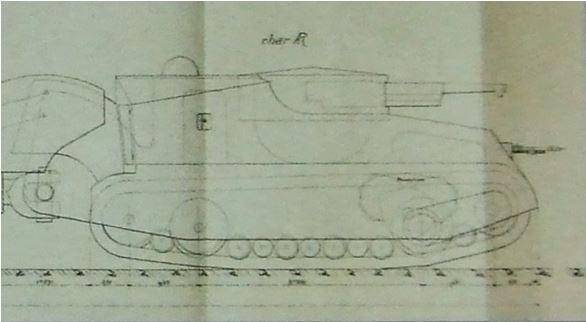
Front Section Layout
In the tower section it was proposed to place a 75 caliber mm gun or other similar weapons. In the front and side hull sheets should also have been 8-mm machine guns. In the case of continuing work on the project, the composition of weapons could change in accordance with the wishes of the customer in the person of the French army.
The central section of the "tank-armored train" was again intended to accommodate the power plant. Like the previous project, it received a rectangular case with its own power plant and chassis, covered with side screens. Inside the central section there should have been a gasoline engine with an 700 horsepower, connected with an electric generator. The cables, through the control system, the current had to flow to the traction motors of all sections of the machine. The chassis of the central section was similar to the units of other parts of the tank.
In the second project of the Boirault Train Blindé, the cardan-type hinge was used again. The supporting devices of the two hinges were located in the lower part of the equipment housings. Above the hinges, at an angle to the horizontal, were placed two sets of shock absorbers and systems for controlling the movement of sections, two for each hinge. The hemispherical hinge casings, consisting of two parts, were used again. In connection with the new design of buildings, L. Buaro decided to locate the lower (inner) housings on the walls of the front and aft sections. The upper housings, in turn, proposed to mount on the central section. Such a placement of the reservation to some extent improved the interaction of parts during the mutual movement of sections of the tank. Hinges retain existing capabilities. Sections could move relative to each other at angles up to 30 ° in either direction.
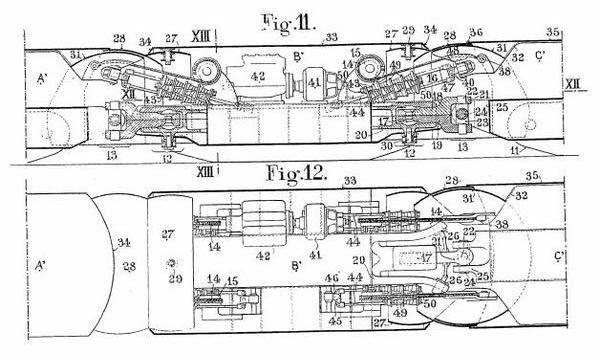
The device of the central section, visible shock absorbers and actuators control the position of the buildings
An increase in armor thickness and weapon enhancement led to a natural result. The estimated combat mass of the “tank-armored train” of the second version reached the level of 125-130 t. It is not difficult to guess what could be the mobility of the armored vehicle with the specific power of the main engine slightly more than 5 hp per ton and electric transmission, further reducing performance.
Whether the projects of the Boirault Train Blindé family were offered to the French army is unknown. At the same time, the absence of any information about the attempt to implement these projects may be evidence of, at a minimum, a lack of interest in such developments. Both "armored trains" of the articulated structure could not get off the drawings. The reasons for this are simple and straightforward. Even by modern standards, a three-section tank with hinges between the corps, having a combat mass of about 75, is an extremely complex machine with dubious prospects. The second version of the L. Buaro tank, which is notable for its more powerful armor and armament, fully preserved all the main shortcomings of its predecessor, and also risked getting new ones.
Thus, the original designs of French tanks had only a few minor advantages, in addition to which were a lot of the most serious flaws. The likelihood that the military will show interest in such a technique, tends to zero. At the construction and testing of prototypes in general should not count. Both projects of the Boirault Train Blindé remained at the design stage. Later they were put into practice, but it was only about large-scale models of armored vehicles.

The scheme of combining three Somua S35 tanks into an articulated vehicle
According to various sources, Louis Bouarot stopped working on the subject of articulated tanks as early as 1917-18. His developments in this area did not interest the military, which is why the inventor switched to other projects. However, the idea of an articulated tank was not forgotten forever. In the mid-thirties, L. Bouarot proposed two new versions of the use of “armored trains”. In this case, however, it was now planned to use the hinges only as an aid to improving the patency of existing types of equipment.
In 1936, the designer proposed a set of tools with which it was possible to combine three medium tanks Somua S35 into a single combat vehicle. Hinges allowed to overcome larger obstacles and improve the maneuverability of technology. After moving through a trench, a funnel, an anti-tank ditch or other difficult obstacle, the crews could disunite their armored vehicles and continue combat work on their own. It was also proposed to combine two tanks with an additional section with its own power plant. In this case, two S35 tanks were supposed to receive feed mounts for coupling with an additional section. The latter’s own engine could further improve tank mobility.
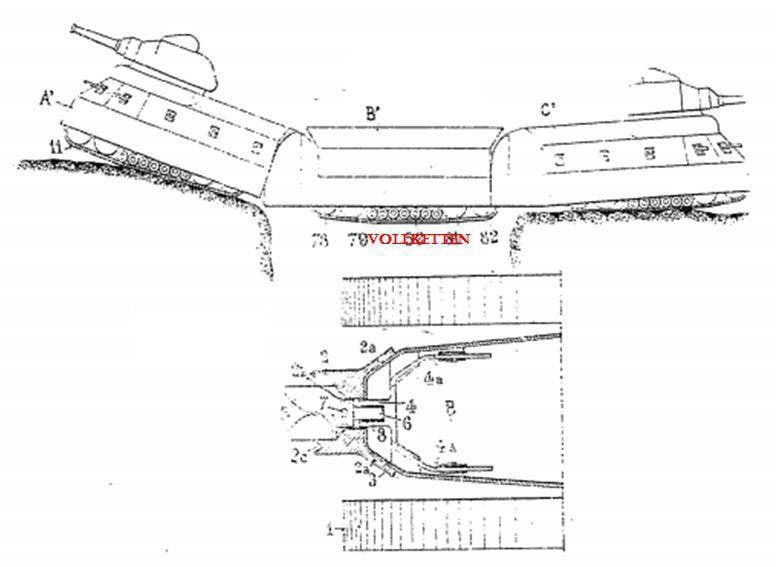
Use of two S35 tanks and an additional section. Below - the hinge device
However, the new project of L. Buaro was not implemented in the metal. The idea of using articulated tanks even after two decades was not able to interest its potential users. It did not help her and the original proposal on the temporary connection of independent armored vehicles. The ideas of the inventor enthusiast were too complex to be used in practice and could hardly be of interest to the military.
Perhaps you should not blame Louis Bouarot for incompetence or projecting. He had to work in the very difficult conditions of his time, when no one yet knew exactly what the future combat vehicle should be. The search for viable concepts and the development of new ideas during 1914-17 first led to the emergence of two original engineering machines capable of literally pushing wire obstacles, as well as two projects of articulated off-road tanks. All these projects did not allow France to begin rearmament of its army, but showed what ideas should not be developed due to the lack of any visible prospects.
On the materials of the sites:
http://landships.activeboard.com/
http://ftr.wot-news.com/
http://landships.info/


Information